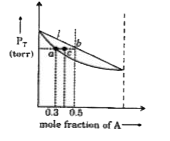Assertion : Due to Frenkel defect, there is no change in the density of the crystalline solid.
Reason : In Frenkel defect, no cation or anion leaves the crystal.Solution in Malayalam
If both (A) and ( R) are correct and ( R) is the correct explanation of(A).
If both (A) and ( R) are correct, but ( R) is not the correct explanation of (A).
If (A) is correct, but ( R) is incorrect.
If both (A) and ( R) are incorrect.
The correct Answer is:A
In Frenkel defect an ion leaves its position in the lattice and occupies normally vacant interstitial position.
Topper's Solved these Questions
- BOOK - BRILLIANT PUBLICATIONCHAPTER - SOLID STATEEXERCISE - QUESTIONS14videos
SOLID STATE
- BOOK - BRILLIANT PUBLICATIONCHAPTER - SOLID STATEEXERCISE - LEVEL-150videos
SOLID STATE
- BOOK - BRILLIANT PUBLICATIONCHAPTER - SOLID STATEEXERCISE - LEVEL-II50videos
SOLID STATE
- BOOK - BRILLIANT PUBLICATIONCHAPTER - REDOX REACTION & ELECTROCHEMISTRYEXERCISE - QUESTION (ELECTROCHEMISTRY) (LEVEL -II) (ASSERTION-REASON)3videos
REDOX REACTION & ELECTROCHEMISTRY
- BOOK - BRILLIANT PUBLICATIONCHAPTER - SOLUTIONSEXERCISE - Level-III (Linked Comprehension Type)12videos
SOLUTIONS
Similar Questions
A compound of elements X and Y crystallizes in cubic structure where X atoms occupy the corners of the cube and Y atoms occupy the centre of the cube. What is the formula of the compound?
02:38View SolutionThe radius of a di val ent cation M2+ is 94 pm and of divalent anion X2− is 146 pm. Thus, M2X2− has
View SolutionTotal number of voids in 0.5 mole of a compound forming hexagonal closed packed structure are
02:13View SolutionAssertion: After the electrolysis of aqueous CuSO4 solution pH decreases.
Reason: Sulphuric acid is formed.02:13View Solution1 mole of A and 1 mole B are mixed together to form an ideal solution at 25∘C. Solution is placed in a vessel fitted with piston. If pressure on the solution is reduced isothermally.

Correct relationship between P∘AandP∘B is02:12View SolutionStatement : Due to Frenkel defect the density of the crystalline solid remains same.
Explanation : In Frenkel defect, no cations or anions leave the lattice.02:01View SolutionAssertion (A) Due to Frenkel defect there is no effect on density of a solid. Reason (R) Ions shift from lattice sites to interstitial sites in Frenkel defect.
02:21View SolutionDue to Frenkel defect, the density of the crystal, …….. Wherease due to schottky defect, it ……
02:22View SolutionDue to Frenkel defect, the density of the crystal __________whereas due to Schottky defect, it..
03:53View SolutionAssertion : Due to Frenkel defect, density of the crystalline solid decreases. Reason : In Frenkel defect, cation or anion leaves the crystal.
View SolutionAssertion (A) Both Frenkel and Schottky defects are stoichiometric defects. Reason (R ) Both defects change the density of the crystalline solid.
01:47View SolutionAssert : due to Frenkel defect, density of the crystalline solid decrases. Reason : in Frenkel defect cation and anion leaves the crystal.
02:39View SolutionThe size of the anion in Frenkel defect crystal is "_____________"
02:24View SolutionStatement - I. Due to Frenkel defect the density of solid decrease. Statement - II. In frenkel defect cation or anion is present at interstitial site leaving lattice sites vacant.
04:49View SolutionAssertion : due to Frenkel defect, density of the crystalline solid decreases. Reason : in Frenkel defect cation and anion leaves the crystal.
03:31View Solution

